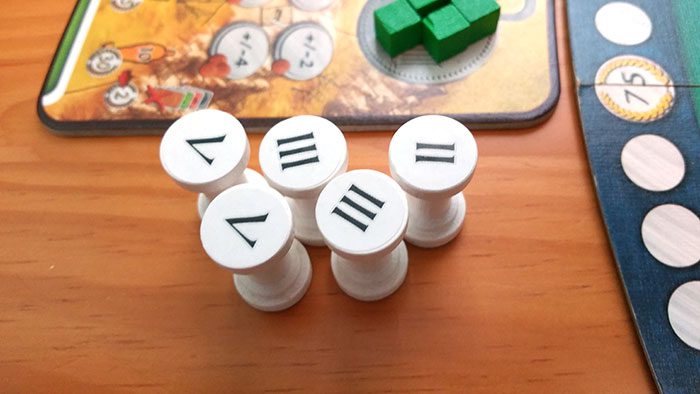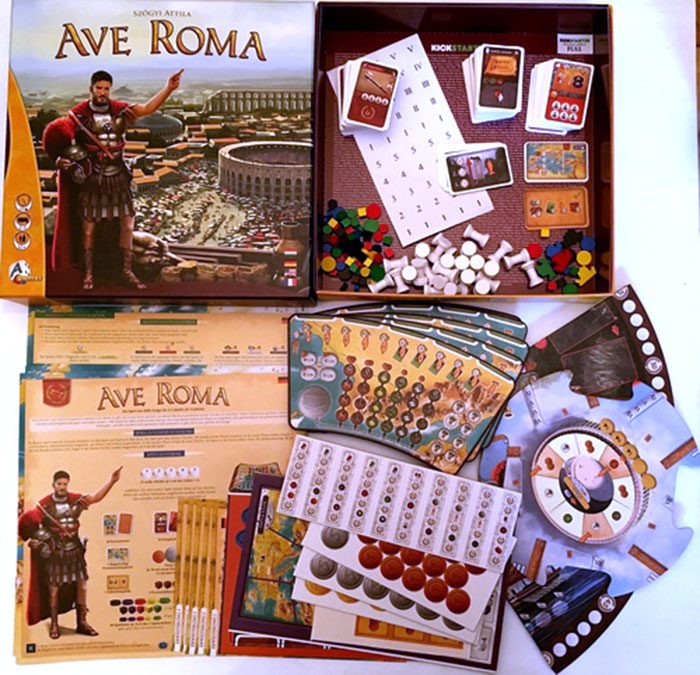First launched on Kickstarter in April of 2016 and canceled just a few short weeks later, Ave Roma was the little game that almost wasn’t. However, the following month the game was relaunched with new pricing, a new look, and a bevy of stretch goals and it went on to blow past every last one of its funding goals. The moment that I saw it, I knew this was one game that I absolutely had to support. It’s got everything I love…
Worker placement? Check. Deeply ingrained theme? Check. Lots of awesome pieces and fiddly bits? Check. High replay value? Check. If you stuck it out this far then get ready! There’s a lot to talk about, but I’ll try to keep it brief. Also, bear in mind when looking at the photos here that these are all photos of the Kickstarter edition of the game. Not all of the pieces that you see are indicative of the pieces that you might find in the retail version.

Overview
Ave Roma is played in a series of rounds in which the players take turns placing their workers at various locations on the board and then carrying out the actions associated with the locations. Some locations allow you to acquire cards that benefit your growing empire while others are static and provide the players with the resources they will need to purchase things. The cards that you have access to and the benefits provided by the various cards will vary depending upon which workers have been placed where (more on the workers momentarily).
Once all of the players have placed all of their workers, there is a refill phase where things are restocked and reset and then all of the players will take turns drafting workers back into their possession. The game continues in this fashion until one of the end game conditions is met. Then the final scores are tallied and a winner is decided. The game ends when either a.) an Area card needs to be drawn but there are no Area cards left to draw or b.) you are unable to refill one of the other card locations on the board during the refill phase.
So, let’s talk about those workers, shall we?

The Workers and the Draft
Each worker in this game has been assigned a number between 1 and 5. At the beginning of the game, each player will start with a full assortment of five workers as pictured above, but this will change as the game moves on and this is what really makes Ave Roma unique.
As in any worker placement game, the workers will provide different benefits depending on where they are placed. Some spaces can only be interacted with by workers that are of a specific number or fall within a specific range of numbers while other spaces can be interacted with by any worker regardless of their number. In other spaces, the benefits provided by the action scales according to the number of the worker that was used to take the action. If this sounds confusing, rest assured that it will become much clearer shortly.
At the end of a round, once everyone has placed all of their workers, the players will take turns drafting workers back into their possession IN REVERSE TURN ORDER. The person in last place will select a board location and collect all of the workers from it, but they are limited to a maximum of five workers. That means that they may have to leave a few workers behind or that they might have to draft from a different location when their turn comes around again. Once they have drafted, the next player in line drafts their workers and this process continues until everyone has drafted five workers each.
At the end of the draft, the players add up the total of all of their worker numbers and this total will determine the play order of the next round. The highest total will go last while the lowest total will go first.

So, when you’re drafting workers, you’re also drafting for turn order as well!
Components & Setup
Opening the box reveals a massive amount of stuff – especially with the Kickstarter version that included 5 or 6 expansions! However, since this is just a review of the base game, I’m not going to talk about the various expansions. And, instead of just rattling off a long list of items that you’ll find inside of the box, we’re going to set up the game together and hit each thing as we move along. That way everything will have some context. As I describe the various areas, we may encounter some terminology that doesn’t make sense, but it will eventually.

So, to begin, we construct the game board. It’s divided into five segments and comes together to form a circle. There’s different artwork on both sides of the board and you can play the game with whichever you choose. Even though everything’s laid out differently, they both contain the same things. On each game board you’ll find:

- The Quaestor: rewards the players with money. The players earn two times the number of the worker that was used to utilize the action. (A worker with a value of 3, for instance, would earn you 6 money) Five spaces for Area cards
- The Aedilis: allows players to interact with the Area cards to earn resources
- The Mercator: allows players to interact with Area cards to buy and/or sell resources
- The Aedificator: allows players to purchase buildings which will award them with victory points (VP) or resources
- The Legatus: allows players to use their surplus goods to support the war effort by buying cards that will award them with victory points and area influence opportunities
- The Propraetor: allows players to interact with Area cards to gain resources as well as raise their influence in specific Area card locations by placing their personal Influence cubes there
- The Senatus: allows players to spend resources to gain Senator cards which provide them with valuable in-game benefits as well as bonus VP at the end of the game
- Roma: allows the players to move along the Colosseum track to increase their political influence. This is how players earn the political influence they will need to actually use the Senators’ powers
- A scoring track along the outer edge
- An area that displays the current turn order

Once the game board has been assembled, each of the various card locations are seeded with the appropriate cards and the remainder of those cards are set aside as separate decks that will be used to replenish the various locations. The Area cards are placed in such a way that the card covers the iconography that exists on the space. Each of the different Area card regions also has one of the brown Area Influence cubes set beside it at the lowest position.
With that all squared away, each player receives one set of workers and a player board. The player boards represent various territories of the Roman empire. Each of the player boards is double-sided and nothing really changes from one board to the next other than the cost of goods. Some regions may value horses more highly than wood or wine while another might place more value on stone. It doesn’t really matter which board you choose or which side you choose to play with.
Each of the players also selects a color and gathers up all of that color’s pieces. They will place their large disks on the 0 space of the scoring track and on the starting space of the Colosseum. A beginning player order is decided in some random fashion and their turn order markers will be placed onto the appropriate spaces in the proper order. Their remaining circular disks will be placed onto their player boards – one per resource. Each player begins with a few resources as well as a couple of surplus. The small cubes are set aside for the time being. They’ll be needed to track the players’ influence gains in the Area card spaces.

The player boards are designed in such a way that they sit flush against the edge of the game board. The space to the left and right of the player board should be kept clear because any cards that you collect will be placed in one of these two locations. Along the bottom edge of the player board is the political influence track. The first five political influence gains will allow the players to use any Senator cards that they have collected or may collect and every political gain will increase the VP value of this track at the end of the game.
The resource values are tracked by adjusting the discs to reflect how many of a particular item a player has. If a player gains more than 3 of a single resource, then this overage is tracked as surplus instead. Beneath each resource track is the cost of each particular resource for the player. This is how much a particular good sells for or can be purchased for. There is also an area where a player can “Train a worker”. Placing a worker here and waiting for at least one turn will increase or decrease that worker’s effective value by the indicated amount. So, a worker with a value of 4 placed on top of the +2/-2 space, for instance, could be placed onto the game board later on as if it had a value of 2, 3, 4, or 5 (5 is the maximum).

Once you’ve got all of this laid out, you’re ready to start playing the game. I’m not going to go into super fine detail about how that’s done, but I will give you a high level overview. Before I do that, though, I’ve got this one last thing to say regarding the components in this game: they’re amazing. The cards are nice and thick. The wooden pieces are solid and sturdy. The artwork is phenomenal. Even the rulebook is of the highest quality. It’s very thick, fairly well written considering it has been translated from Hungarian into English, and chock full of examples. My one beef with the rulebook is that it is not the most organized. There were a lot of questions that came up during my first playthrough and it was not always a simple matter to find the answers, but the answers WERE there.
Anatomy of a Round
In turn order, each player is going to take turns selecting one of their workers and performing an action with it. Whenever one of the Area cards is interacted with in any way for the first time, it slides upward revealing the iconography beneath. The next time that it is interacted with, the player interacting with it must pay 2 money and take the card into their possession. If they do not have a way to pay this 2 money, they cannot take the action. Once the card is removed, the brown Area Influence cube moves up a space and another Area card is drawn to refill the location.

At the end of the game, the players’ personal Influence cubes will slide down to match the level of where the brown Influence cube currently is. Since only one Influence cube at a time can occupy a space, this may mean that some players’ cubes will get pushed further down the track or even off of the track entirely. The VP total for each specific Area will vary based upon where the brown Influence cube ended up at the end of the game. So, the higher the players can push that brown cube, the better off it will be for them if they’ve got a dog in the fight, so to speak. This VP is added to the VP that the players earn from elsewhere and the person with the highest VP total wins.

Thoughts
This game is phenomenal. It’s very eye catching and has a great table presence. Gyula Pozsgay and Attila Szőgyi have both done an amazing job on the graphics here. When Ave Roma hits the table, people constantly wander over to see what it is. Mechanically speaking, all of the various elements work very well together and they all have a lot of good synergy. It’s a massive game with a lot of stuff going on and none of it is fluff. Everything that’s there belongs there.
While the action selection is obviously very important, the meat of the game takes place where you least expect it: the worker draft. There are a lot of tough decisions to make here. Do you intentionally draft low numbered workers so that you can go first the next round or do you draft higher numbered workers so that your actions will be of greater benefit to you in the upcoming round? Drafting low will mean that your actions will be more limited but guarantees you that you’ll get what you want before anyone else has a chance to mess with your plans. Drafting high means that you’ll be going last and that could mean missing out on some golden opportunities. In this game, these are very critical decisions and making the wrong ones can spell the difference between victory and doom.
And this brings me to the only really negative thing that I have to say about this game aside from my earlier gripe about the rule book. Namely, this game provides you with a plethora of possibilities each and every turn and it’s not always easy to decide which one you should take. This can lead to some very long turns and can drag the game out longer than you might like it to. It can be especially bad if you’re playing with people that are prone to analysis paralysis (I’m a guilty party!).
However, that being said, if you’re willing to work through that, you’ll discover a very meaty game with a lot of heft to it. Ave Roma is a very solid worker placement game and it’s one of the best and one of the most unique that I have ever played. This is a purchase that I definitely do not regret.










